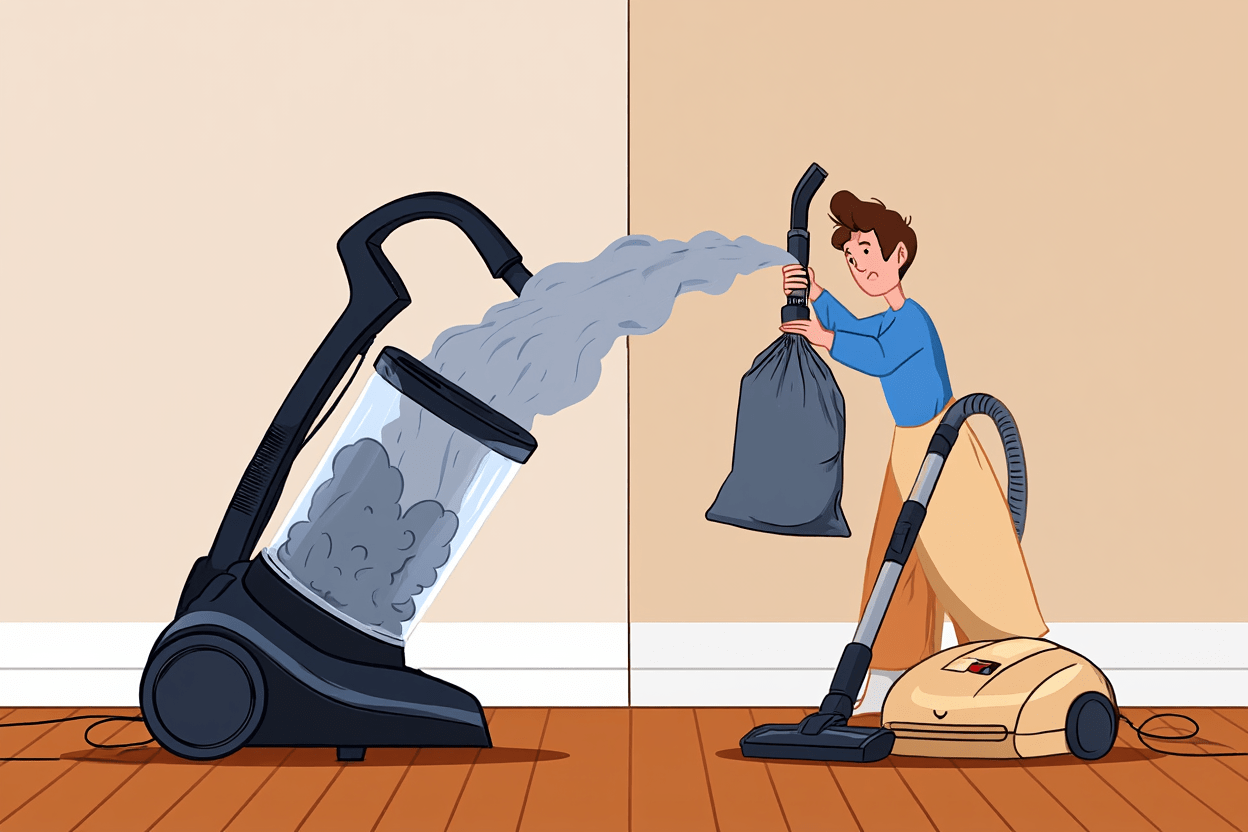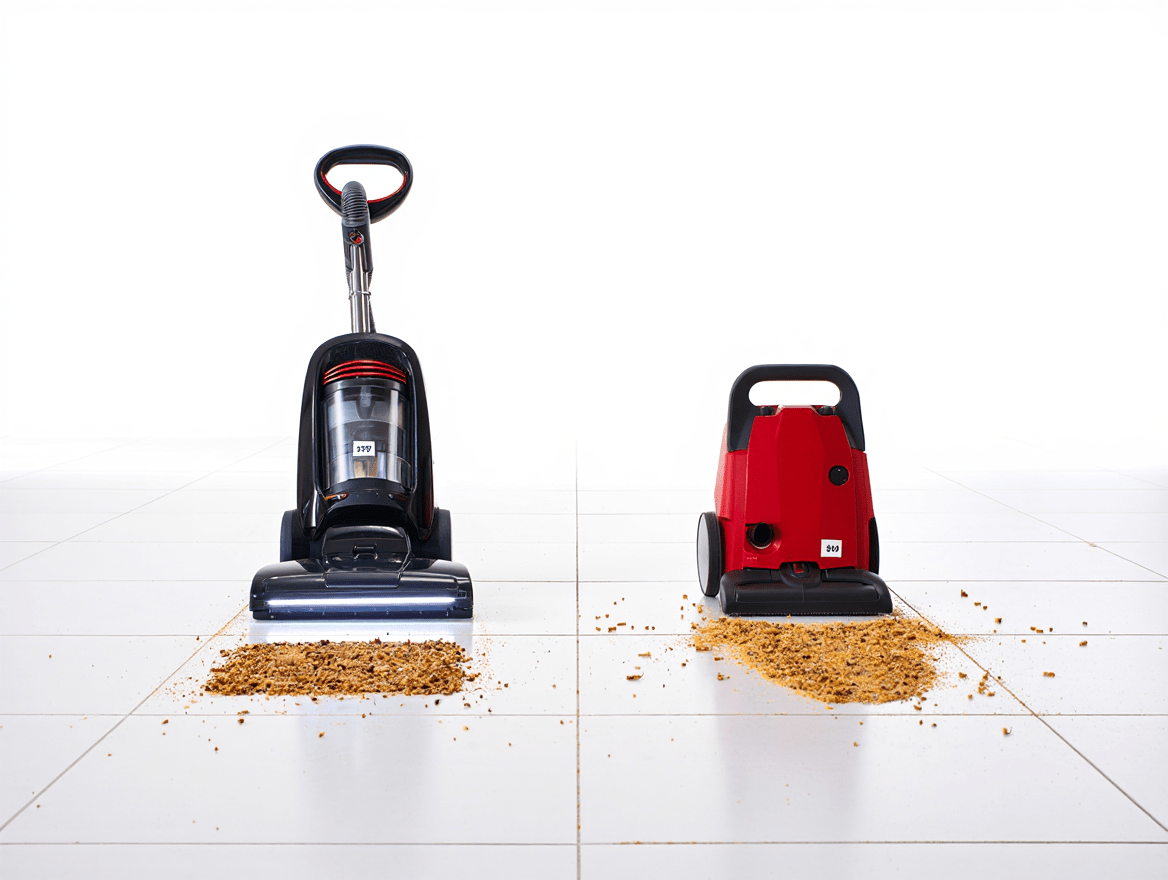Many homeowners unknowingly waste money and reduce cleaning efficiency because of common vacuum myths. Beliefs like “more suction is always better” or “all vacuums clean the same” can lead to poor choices, frequent replacements, or unnecessary expenses. These misconceptions not only affect your wallet but also your home’s cleanliness and indoor air quality. Understanding the truth behind these myths helps you make smarter decisions, maintain your vacuum for longer, and save on energy and repair costs.
In this guide, I’ll debunk seven of the most common vacuum myths and give practical tips to maximize performance and minimize expenses.
- Why Debunking Vacuum Myths Matters?
- Myth 1: More Suction Always Means Better Cleaning
- Myth 2: You Only Need to Vacuum When Floors Look Dirty
- Myth 3: All Filters Work the Same
- Myth 4: You Don’t Need to Clean Your Vacuum
- Myth 6: Upright Vacuums Are Always Better
- Myth 7: Robot Vacuums Replace Manual Vacuuming
- Practical Cleaning Tips to Save Money
- Cost, Lifespan, and Replacement Advice
- Final Words
- FAQs
Why Debunking Vacuum Myths Matters?
Before we tackle specific myths, it’s important to understand how misconceptions impact both cleaning efficiency and costs.
Wasting Money on the Wrong Vacuum
Many people buy vacuums based on brand reputation or misleading marketing claims. Overspending on a high-end upright for a small apartment, for instance, provides little real benefit compared to a lightweight stick or handheld vacuum that is easier to store and maintain.
On the other hand, buying a low-end vacuum without essential features often leads to frequent repairs or early replacement, costing more in the long run.
Reduced Cleaning Efficiency
Believing myths like “all vacuums are equally effective” can result in missed dirt, allergens, and pet hair. Over time, this increases cleaning frequency, energy consumption, and the need for professional carpet or upholstery cleaning.
Shortened Vacuum Lifespan
Neglecting proper maintenance, based on myths like “vacuums clean themselves,” leads to clogged filters, worn-out brush rolls, and motor strain. This reduces suction efficiency and accelerates the need for costly replacements.

Myth 1: More Suction Always Means Better Cleaning
Many people assume the vacuum with the highest suction is the best, but this isn’t always true.
Understanding Suction
Suction strength is important but not the only factor for effective cleaning. On carpets, brush rolls or agitators are often more critical than raw suction because they lift dirt trapped deep in fibers. High suction alone may even damage delicate rugs or wooden floors.
Real-World Example
A family bought a $500 stick vacuum with extreme suction but no motorized brush roll. It removed surface dust but left embedded pet hair behind. Conversely, a moderate-suction vacuum with a motorized brush roll cleaned carpets more thoroughly in fewer passes.
Practical Tips
Match suction to your flooring and cleaning needs. For carpeted homes, prioritize a vacuum with brush rolls or agitators. For hardwood, moderate suction with soft wheels prevents scratches. High suction is valuable, but proper attachments and features often matter more.
Myth 2: You Only Need to Vacuum When Floors Look Dirty
Many homeowners wait until dirt is visible, thinking occasional cleaning is enough.
Hidden Costs of Waiting
Visible dirt is only a small fraction of the dust, allergens, and pet dander accumulating in carpets and upholstery. Neglecting regular vacuuming results in:
- Poor indoor air quality
- Faster carpet fiber wear
- Increased need for professional cleaning services
Example
A couple with cats vacuumed only once a month. They noticed higher allergy symptoms and spent $200 yearly on professional carpet cleaning—costs they could have avoided with weekly vacuuming.
Expert Advice
Vacuum floors at least weekly, and high-traffic areas or homes with pets may require 2–3 times weekly. Regular maintenance reduces allergens, prevents wear, and keeps cleaning sessions shorter and easier.
Myth 3: All Filters Work the Same
Not all filters are created equal.
The Truth About Filtration
Filters vary in quality and effectiveness. HEPA filters trap microscopic dust, pollen, and pet dander, while standard filters may allow these particles to recirculate. Homes with allergy sufferers or pets require high-quality filtration to maintain indoor air quality.
OEM vs. Aftermarket Filters
Original equipment manufacturer (OEM) filters often last longer and maintain suction better than aftermarket replacements. Cheap aftermarket filters may degrade quickly, reducing cleaning efficiency and increasing long-term costs.
Practical Tips
Invest in the correct filter for your vacuum and clean or replace it regularly. Even a high-end vacuum loses effectiveness with a clogged or incompatible filter. Consider models with washable HEPA filters to save money over time.
Myth 4: You Don’t Need to Clean Your Vacuum
Many assume vacuums are self-cleaning, but neglecting maintenance is costly.
Importance of Routine Maintenance
Dustbins, brush rolls, and filters accumulate hair, dirt, and debris. Ignoring maintenance reduces suction, strains the motor, and shortens vacuum lifespan. Small problems compound over time, leading to costly repairs.
Real-World Example
A handheld vacuum left uncleaned for six months lost half its suction and required a $120 motor repair. Regular cleaning of the dustbin and brush roll could have prevented the damage.
Cost-Saving Tip
Empty dustbins after each use, clean brush rolls monthly, and replace filters as recommended. These simple habits ensure long-term efficiency and reduce replacement costs.
Myth 5: Bagless Vacuums Are Always Cheaper
Bagless vacuums are marketed as cost-saving, but there are hidden expenses.
The Reality
Bagless models eliminate bag replacements, but many require frequent filter replacements and more frequent cleaning. HEPA filters for bagless models can cost $40 or more annually.
Real-World Example
A bagless stick vacuum required quarterly HEPA filter replacements at $40 each, costing more over three years than a bagged vacuum with $10 replacement bags.
Practical Advice
Evaluate total ownership costs—including filters, maintenance, and energy use—before choosing a bagless model. Sometimes bagged vacuums are more economical long-term.
Myth 6: Upright Vacuums Are Always Better
The Truth About Uprights
While upright vacuums are powerful and ideal for large homes or deep carpets, they aren’t always the best choice for every household. They are heavy, take up more storage space, and can be difficult to maneuver in apartments, small spaces, or multi-level homes. A lightweight stick or cordless vacuum can clean more efficiently in tight areas and save energy.
Real-World Example
A studio apartment resident purchased a top-of-the-line upright vacuum but found it cumbersome. The heavy unit was difficult to use on stairs and under furniture, leading to irregular cleaning and extra labor. Switching to a cordless stick vacuum reduced cleaning time by 50% and made storage easier.
Practical Tips
Choose a vacuum that matches your living space, floor type, and physical capabilities. Uprights are best for large carpeted areas, but lightweight stick or handheld models may provide better efficiency in smaller homes.
Myth 7: Robot Vacuums Replace Manual Vacuuming
Understanding Robot Limitations
Robot vacuums are convenient, but they don’t completely replace manual cleaning. Most robots struggle with stairs, tight corners, upholstery, and heavy debris. Believing they eliminate the need for other vacuums can lead to missed dirt and faster wear on carpets.
Real-World Example
A family invested in a high-end robot vacuum expecting full automation. While it handled daily floor touch-ups well, hair, dust in corners, and crumbs under furniture still required manual vacuuming. Combining robot vacuums with handheld or stick vacuums provided thorough cleaning and reduced long-term maintenance costs.
Practical Tips
Use robots as a supplement for regular cleaning, not a full replacement. Schedule daily or weekly robot cleaning for open floor areas and combine with manual vacuuming for edges, stairs, and furniture.
Practical Cleaning Tips to Save Money
Routine Maintenance
Regular vacuum maintenance prevents costly repairs. Key tasks include:
- Emptying dustbins after each use
- Cleaning or replacing filters as recommended
- Untangling hair from brush rolls
- Checking batteries in cordless vacuums
Smart Cleaning Habits
- Vacuum high-traffic areas more frequently to prevent dirt accumulation.
- Use attachments for corners, upholstery, and furniture to reduce deep-cleaning frequency.
- Alternate vacuuming patterns (north-south, east-west) for thorough coverage.
Energy and Cost Efficiency
- Choose vacuums with appropriate suction for your flooring type to reduce electricity use.
- Stick or handheld vacuums are ideal for quick tasks, avoiding unnecessary use of larger, energy-intensive units.
- HEPA filters improve air quality, reducing health-related costs associated with allergens.
Cost, Lifespan, and Replacement Advice
Average Lifespan
Most modern vacuums last 5–8 years with proper care. Cordless models may require battery replacement every 2–3 years, while motorized brush rolls and filters should be checked regularly.
Signs It’s Time to Replace
- Loss of suction despite cleaning filters and dustbins
- Loud or unusual noises
- Persistent odors
- Frequent clogging or repeated maintenance
OEM vs. Aftermarket Parts
Original manufacturer parts often maintain suction, airflow, and motor efficiency better than aftermarket replacements. Using OEM parts may cost more initially but saves money by prolonging the vacuum’s lifespan.
Long-Term Value
Investing in the right vacuum type and performing regular maintenance reduces overall costs. Avoiding common myths—like buying vacuums based solely on suction or skipping maintenance—ensures your vacuum lasts longer and cleans more effectively.
Final Words
Believing vacuum myths can cost you money, reduce cleaning efficiency, and shorten your vacuum’s lifespan. High suction isn’t always better, robot vacuums don’t fully replace manual cleaning, and proper maintenance is essential. By debunking these seven myths, homeowners can select the right vacuum for their needs, maintain it effectively, and save money on replacements and repairs. Regular cleaning, appropriate attachments, and OEM parts ensure optimal performance. Understanding the truth behind vacuum myths empowers you to make smarter purchasing and maintenance decisions, resulting in a cleaner, healthier home without unnecessary expenses.
FAQs
Does higher suction always mean better cleaning?
No. Suction matters, but brush rolls, attachments, and filtration often impact cleaning more. Matching features to your flooring and cleaning needs is key.
Can robot vacuums fully replace manual vacuuming?
No. Robots handle open floor areas well but often miss corners, stairs, and upholstery. Use them as a supplement to manual vacuums.
Are bagless vacuums truly cheaper?
Not always. Bagless vacuums eliminate bag costs but may require expensive HEPA filter replacements and frequent maintenance, increasing long-term costs.
Do all filters perform the same?
No. HEPA filters trap fine dust and allergens better than standard filters. OEM filters maintain suction longer than cheaper aftermarket versions.
How often should I vacuum to prevent damage and save money?
High-traffic areas should be vacuumed 2–3 times per week; low-traffic areas weekly. Regular maintenance reduces carpet wear and replacement costs.
Can upright vacuums be inefficient in small spaces?
Yes. Uprights are heavy and hard to maneuver in tight areas. Lightweight stick or handheld models are often more efficient for small apartments or multi-level homes.
Will skipping vacuum maintenance save money?
No. Neglecting cleaning and maintenance reduces suction, strains the motor, and leads to costly repairs or early replacement. Regular upkeep saves money long-term.
